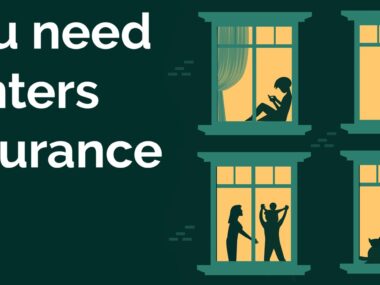Flood insurance in Canada is an essential safeguard against the financial devastation that flooding can cause. Given the country’s diverse geography, which includes everything from coastal regions to vast river systems and urban centers, many areas are at risk of flooding.
This type of insurance helps homeowners and renters recover from the damage caused by floods, which can result from heavy rainfall, rapid snowmelt or storm surges. By having flood insurance, Canadians can ensure they have the financial resources to repair and replace damaged property, making it a critical component of comprehensive home protection.
The two main types of flood insurance in Canada are overland flood insurance and sewer backup insurance. Overland flood insurance covers damage from water that flows overland into homes, such as from overflowing rivers or heavy rain.
In contrast, sewer backup insurance covers damage caused by the overflow of municipal sewer systems, a common issue during periods of heavy rainfall when infrastructure can become overwhelmed. Understanding the differences between these coverages is crucial for homeowners to ensure they have adequate protection tailored to their specific risks and needs.
Securing flood insurance in Canada involves assessing the risk based on location, property type and historical flood data. Homeowners need to research and compare different insurance providers, request quotes and understand the coverage limits and exclusions. Many insurers conduct detailed risk assessments to determine premiums and coverage options.
By choosing the right flood insurance policy, homeowners can gain peace of mind knowing they are financially protected against one of nature’s most unpredictable and costly disasters. In a country where extreme weather events are becoming more frequent, having flood insurance is a proactive step towards safeguarding one’s home and financial stability.
Why Flood Insurance in Canada is Essential
Flooding can occur anywhere in Canada, from the coastal regions to the heartland. Whether caused by heavy rainfall, rapid snowmelt or storm surges, floods can wreak havoc on homes and businesses. Without flood insurance, Canadians might face insurmountable repair costs and financial losses.
Types of Flood Insurance in Canada
Flood insurance in Canada generally comes in two main forms: overland flood insurance and sewer backup insurance.
Overland Flood Insurance
This type of insurance covers damage from water that flows overland and enters your property, such as from rivers, lakes or heavy rainfall. Overland flood insurance is particularly important for those living in flood-prone areas or near bodies of water.
Sewer Backup Insurance
Sewer backup insurance covers damage caused by the overflow of sewer systems, which can occur during heavy rains when the municipal system is overwhelmed. This type of coverage is crucial for urban areas where sewer systems might be older or inadequate to handle extreme weather events.
How Flood Insurance in Canada Works
Understanding how flood insurance works can help you make informed decisions about your coverage needs.
Coverage Details
Flood insurance typically covers the cost to repair or replace your property and belongings damaged by flooding. This can include structural repairs, electrical and plumbing systems, appliances, furniture and personal items.
Exclusions
It’s important to be aware of what flood insurance doesn’t cover. Common exclusions include damage from gradual seepage, maintenance-related issues and water damage from within the home, like burst pipes (which are usually covered under standard home insurance policies).
Criteria for Flood Insurance in Canada
Not everyone qualifies for flood insurance in Canada and eligibility can depend on various factors.
Location
Your home’s location is a significant factor in determining your eligibility and premiums for flood insurance. Properties in high-risk flood zones might have higher premiums or limited coverage options.
Property Type
The type of property you own can also affect your eligibility. For instance, some insurers may not offer flood insurance for vacation homes or certain types of structures like mobile homes.
Risk Assessment
Insurers often conduct a risk assessment, which can include evaluating historical flood data, proximity to water bodies and local infrastructure. This assessment helps determine your premium and coverage limits.
Application Process for Flood Insurance in Canada
Applying for flood insurance in Canada involves several steps.
Research and Compare
Start by researching different insurance companies and comparing their flood insurance offerings. Look at coverage details, exclusions, premiums and customer reviews to find a policy that fits your needs.
Get a Quote
Once you’ve identified potential insurers, request quotes. You’ll need to provide details about your property, its location and any previous claims history.
Risk Assessment
The insurer will likely conduct a risk assessment, which might involve a site visit or the use of flood maps and other data. This helps them determine your risk level and set your premium.
Choose and Purchase
After reviewing quotes and risk assessments, choose the policy that best meets your needs and budget. You can then purchase the policy and arrange for payment, either in full or through installments.
Benefits of Flood Insurance in Canada
Flood insurance offers numerous benefits, providing peace of mind and financial protection.
Financial Security
The primary benefit of flood insurance is financial security. It ensures you won’t be left footing a massive bill for repairs and replacements if your home is damaged by flooding.
Peace of Mind
Knowing you’re protected against one of the most common and costly natural disasters can provide significant peace of mind. This is especially true if you live in a high-risk area.
Property Value Protection
Having flood insurance can help protect the value of your property. Potential buyers may be more interested in a home that’s adequately insured against flooding, knowing they won’t face unexpected repair costs.
Companies Offering Flood Insurance in Canada
Several insurance companies offer flood insurance in Canada. Here are some of the key players:
Intact Insurance
Intact Insurance is one of the largest providers of flood insurance in Canada, offering comprehensive coverage options for both overland flooding and sewer backups.
Aviva Canada
Aviva Canada provides flood insurance that can be tailored to meet individual needs, with a strong focus on customer service and support.
The Co-operators
The Co-operators offer a range of flood insurance options, including coverage for overland flooding and sewer backups. They are known for their community involvement and customer-centric approach.
TD Insurance
TD Insurance provides flexible flood insurance options, including add-ons to existing home insurance policies. They offer detailed risk assessments to help homeowners understand their coverage needs.
How to Choose the Right Flood Insurance Policy
Choosing the right flood insurance policy involves considering several factors:
Coverage Limits
Make sure the policy covers the full value of your home and belongings. Understand the maximum payout limits and ensure they’re sufficient to cover potential losses.
Deductibles
Consider the deductible amount-the portion of a claim you must pay out-of-pocket before insurance kicks in. Higher deductibles can lower your premium but increase your out-of-pocket costs in the event of a claim.
Policy Exclusions
Carefully review the policy exclusions to understand what’s not covered. This will help you avoid unpleasant surprises if you need to make a claim.
Customer Service
Look for insurers with a reputation for good customer service. Check reviews and ratings to gauge customer satisfaction and the ease of filing claims.
Discounts
Ask about discounts. Some insurers offer discounts for measures that reduce flood risk, such as installing sump pumps, backwater valves or using flood-resistant building materials.
Flood Preparedness and Mitigation
Having flood insurance is crucial, but it’s also important to take steps to mitigate the risk of flooding and prepare for potential disasters.
Floodproofing Your Home
Consider floodproofing measures such as installing sump pumps, sealing cracks in foundations and raising electrical systems above potential flood levels.
Creating an Emergency Plan
Have an emergency plan in place. Know the evacuation routes and have a kit ready with essentials like water, food, medications and important documents.
Staying Informed
Stay informed about flood risks in your area. Sign up for local alerts and monitor weather forecasts, especially during heavy rain or snowmelt seasons.
Flood Insurance Claims Process
If you need to file a flood insurance claim, understanding the process can help ensure a smooth experience.
Document the Damage
As soon as it’s safe, document the damage with photos and videos. This evidence will be crucial when filing your claim.
Contact Your Insurer
Notify your insurer as soon as possible. Provide them with the documentation of the damage and any other required information.
Assessment and Repair
The insurer will send an adjuster to assess the damage. Once the assessment is complete, the insurer will provide a payout to cover the repair costs. Make sure to keep receipts for all repairs and replacements.
The Importance of Flood Insurance in Canada
Flood insurance in Canada is more than just a policy; it’s a lifeline for homeowners and renters facing the increasing threat of flooding. By understanding the types of coverage available, how the insurance works and the benefits it provides, you can make informed decisions to protect your property and financial well-being. Remember, flood insurance is not just about safeguarding your home-it’s about securing peace of mind in a world where climate change and extreme weather events are becoming more common. Stay informed, prepared and insured to navigate the challenges of flooding in Canada.
Frequently Asked Questions
How do I know if I need flood insurance?
You may need flood insurance if you live in a flood-prone area, near bodies of water or in a region with a history of heavy rainfall or rapid snowmelt. Check with your insurance provider to assess your risk based on your location and property type.
What does overland flood insurance cover?
Overland flood insurance covers damage caused by water that flows overland into your home, such as from overflowing rivers, lakes or heavy rainfall. It typically includes repairs to the structure, electrical systems and personal belongings damaged by floodwaters.
What is sewer backup insurance and what does it cover?
Sewer backup insurance covers damage caused by the overflow of municipal sewer systems, which can happen during heavy rains when the system becomes overwhelmed. It includes repairs to the property and replacement of damaged items affected by the backup.
Are there exclusions in flood insurance policies?
Yes, common exclusions in flood insurance policies include damage from gradual seepage, maintenance issues and internal water damage such as burst pipes. It’s important to read the policy carefully to understand what is and isn’t covered.
How can I apply for flood insurance in Canada?
To apply for flood insurance, research and compare different insurers, request quotes and provide details about your property and its risk factors. An insurer may conduct a risk assessment to determine your premium and coverage options.
What factors affect the cost of flood insurance?
The cost of flood insurance can be influenced by factors such as your property’s location, its proximity to water bodies, the type of coverage you choose and the risk assessment conducted by the insurer. Higher risk areas generally have higher premiums.
How do I file a flood insurance claim?
To file a claim, document the damage with photos and videos, contact your insurer as soon as possible and provide any required information. The insurer will send an adjuster to assess the damage and determine the payout for repairs.
Which companies offer flood insurance in Canada?
Several companies offer flood insurance in Canada, including Intact Insurance, Aviva Canada, The Co-operators and TD Insurance. It’s advisable to compare their offerings, coverage options and customer reviews to find the best policy for your needs.



